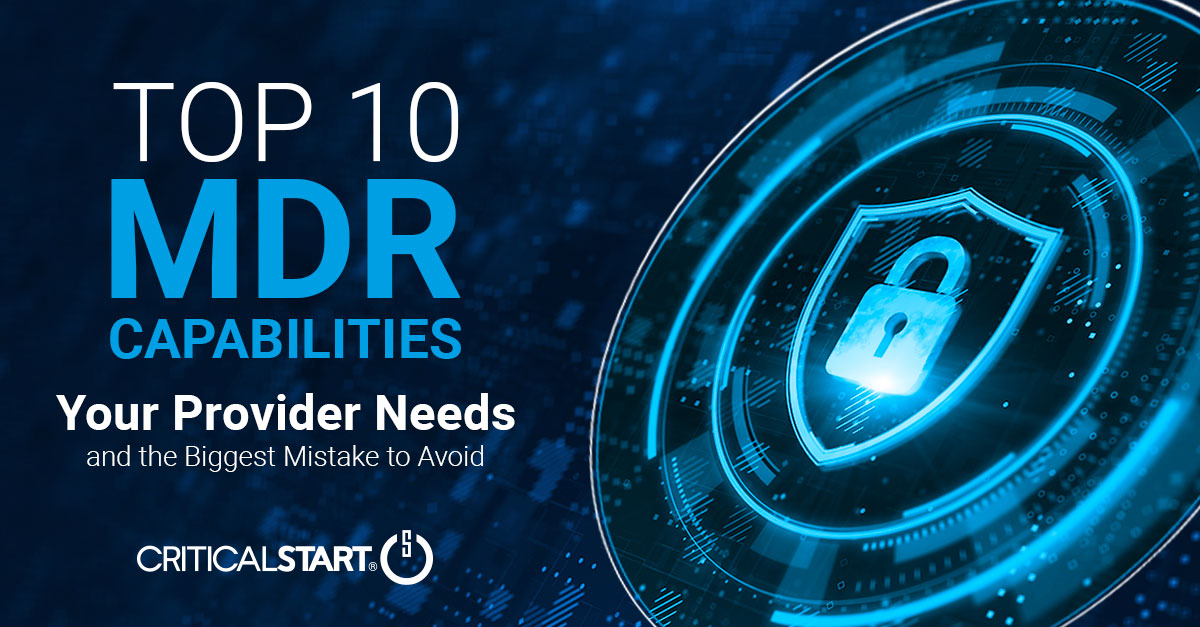The Top 10 MDR Capabilities your Provider Needs (and the Biggest Mistakes to Avoid)

MDR services are gaining popularity as organizations seek more effective measures to identify and respond to security threats. With the increasing frequency and sophistication of cyberattacks, it’s crucial to choose the right MDR provider to reduce your risk exposure and protect your critical assets.
When choosing an MDR provider, it’s essential to know the top capabilities that can maximize your investment and bring you peace of mind. In our latest whitepaper, MDR Providers Decoded: A Comprehensive Guide to Evaluating the Top 10 Capabilities your Provider Needs, we identify the essential capabilities that an MDR provider should possess to ensure they are providing the most effective MDR service per dollar invested to reduce risk for your organization.
Beyond the top capabilities to evaluate when choosing an MDR provider, we also want to highlight the biggest mistakes to avoid when shopping for MDR services. An MDR provider is an extension of your team, and choosing the right provider is a crucial decision to help you rest easy and be able to prove the value of your investment with metrics and reporting, while knowing that the provider has your back both on and off the clock.
MDR Providers Decoded: A Comprehensive Guide to Evaluating the Top 10 Capabilities your Provider Needs
Our latest whitepaper details the top 10 capabilities you should look for while evaluating MDR providers. While we won’t go into detail here, organizations should consider these capabilities while shopping for an MDR service:
24x7x365 Monitoring
MDR providers should have the capability to monitor your Endpoint Detection and Response (EDR), Extended Detection and Response (XDR), and Security Information and Event Management (SIEM) 24x7x365.
Advanced Threat Detection
The MDR service should have advanced threat detection capabilities that can detect both known and unknown threats. This includes resolving every alert to identify attackers using LOLbins (live off the land binaries) to evade “critical” severity detections.
Real-Time Actionable Views of Attacks
Your provider and their technology should be able to deliver real-time actionable views of attacks so that your security team can quickly understand the scope and severity of an attack and make informed decisions about how to respond and remediate security incidents.
Support for Multiple Vendors
MDR providers should support multiple vendors to both detect and response to attacks across EDR, XDR, and SIEM.
Seamless Workflow Integration
The services and technology should support seamless integration with your existing security workflows, including integrating with incident response plans and defining specific rules of engagement around response actions.
Comprehensive Reporting
The provider and their technology should provide comprehensive reporting that gives you a clear understanding of your security posture and the value of the MDR provider.
For more details on the above, and the other top capabilities you should evaluate when looking at MDR providers, check out our whitepaper, checklist, and other resources. However, while shopping and comparing MDR providers, it’s essential to remember a few pitfalls to avoid as well.
The Biggest Mistakes to Avoid when Shopping for an MDR Provider
Focusing only on price: While cost is important, it shouldn’t be the only factor. For example, a cheaper solution may not offer the same level of protection as a more expensive one. It’s important to evaluate all the capabilities of the provider to ensure that you are getting the best value per dollar invested and ensuring that you can demonstrate that return on investment (ROI) to leaders within your organization.
Not considering the provider’s expertise: The provider should have a proven track record of detecting and responding to threats effectively, and you should evaluate their experience, certifications, and qualifications before making a decision. Don’t be afraid to ask the provider for customer references, so you can speak to their customers first-hand about their experiences.
Overlooking the provider’s technology: It’s crucial to choose an MDR provider that uses the latest technology and tools. Focusing on a provider that invests in technology and keeps up with the latest trends and developments is key.
Ignoring the provider’s reporting capabilities: Effective reporting is critical to managing and mitigating cyber threats. You should look for an MDR provider that offers comprehensive and customizable reporting capabilities that highlight team productivity, ROI, and allows you to benchmark against peers.
Choosing a provider without evaluating their customer service: Finally, it’s important to choose an MDR provider that emphasizes onboarding support and customer success. You should evaluate their level and quality of customer service by checking references, reading reviews, and asking for feedback from current customers.
By avoiding these common mistakes and thoroughly evaluating potential MDR providers with the capabilities listed above, organizations can choose the best solution to protect their critical assets from cyber threats. If you have more questions, we’d love to chat. Critical Start is the only MDR provider on the market today that focuses on the resolution of all alerts to decrease both your risk exposure and operating expenses. Contact us today to speak to an expert about how Critical Start may be the best MDR provider for your organization.

CTO
As the Chief Technology Officer and an emerging thought-leader in the security industry, Randy is responsible for designing and executing the company’s strategic technology initiatives, which includes defining the strategy and direction of CRITICALSTART’s Managed Detection and Response (MDR) services delivered by the Zero-Trust Analytics Platform® (ZTAP). Previously, Randy served as the Director of Security Architecture, where he set the strategy for emerging vendor technologies, created the Defendable Network reference architecture, and set product direction for the company’s internally-developed Security Orchestration Automation and Response platform.
You may also be interested in…
RESOURCE CATEGORIES
- Buyer's Guides(1)
- Consumer Education(39)
- Consumer Stories(2)
- Cybersecurity Consulting(4)
- Data Breaches(15)
- Data Privacy(43)
- Incident Response(2)
- Interview(51)
- MDR Services(59)
- MobileSOC(6)
- News(5)
- Press Release(101)
- Research Report(9)
- Security Assessments(2)
- Thought Leadership(19)
- Threat Hunting(3)
- Video(1)
- Vulnerability Disclosure(1)